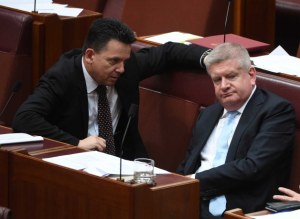
The government has secured enough Senate support to push through the biggest overhaul of media ownership laws in 30 years after clinching a deal with Nick Xenophon yesterday.
A $60 million package to help regional and small news outlets secured three Nick Xenophon Team senators to the cause, helping communications minister Mitch Fifield surpass the 10 crossbench votes needed for the bill to pass through Senate.
Other backers include 29 Coalition senators, four One Nation’s senators, Derryn Hinch, Lucy Gichuhi, David Leyonhjelm and Cory Bernardi.
Senators opposed include 26 from Labor, seven from The Greens and Jacqui Lambie.
The reforms have been stuck in the Senate since June with the Government making a range of concessions to win over vital blocks of support from One Nation and Nick Xenophon Team.
These include a raft of measures that could potentially weaken the ABC, such as a competitive neutrality review, in exchange for Hanson’s support. Her personal vendetta against the public broadcaster making its way into the package was a risky move that cost Fifield the support of Lambie and threatened to unsettle others.
Xenophon took several months to shake hands with the government. The package includes a $50 million one-off regional and small publishers innovation fund that will run for three years.
This applies to Australian publishers with an annual revenue of between $300,000 and $30 million. It also includes support for 200 cadetships under a regional and small publishers program.
“The grants will be able to be used by publishers for initiatives that support the continuation, development, growth and innovation of Australian civic journalism, including initiatives that explore and expand the journalism funding model,” NXT said in a statement.
The government has also agreed to ask Australia’s competition watchdog, the ACCC, to conduct an inquiry into the impact of the new digital environment on media.
Breaking down barriers
Fifield’s media reforms are the first major changes to media ownership rules that take into account the upheaval caused by online media and global internet companies on newspapers, TV networks, radio stations as audiences and advertising dollars decline.
They dismantle market barriers that were introduced in Keating's media reforms of 1987. This will allow a media company to own media assets in TV, radio and print in a single market. It also removes the 75% reach rule, which means metropolitan TV networks will be able to broadcast anywhere in Australia.
The media reforms aim to relax ownership barriers that have shackled traditional media companies from consolidating and aim to remove dated restrictions that do not apply to new market players such as global digital media companies, social media platforms and internet streaming platforms.
The reforms also remove some of the sports events listed on the anti-siphoning list and place restrictions on gambling advertising. Another significant boost within the package is replacing the draconian broadcast license fee with a more reasonable fee based on spectrum costs.
Labor and The Greens opposition to media reforms is based on concerns about media diversity if the two-out-of-three rule is removed. Aside from the rule being largely redundant, a greater risk to media diversity is the collapse of a major media company like Ten.
Ownership deregulation clears the way for market consolidation, allowing media companies to build scale and diversify product offerings across multiple media channels at a time when digital tech companies are consuming most of the growth in advertising.
Have something to say on this? Share your views in the comments section below. Or if you have a news story or tip-off, drop us a line at adnews@yaffa.com.au
Sign up to the AdNews newsletter, like us on Facebook or follow us on Twitter for breaking stories and campaigns throughout the day.


